|
Wherry
& Sons Ltd
There has been
an unbroken line of family control at Wherry & Sons Ltd since
the company started in business at Bourne in 1806, the year following the
Battle of Trafalgar. Edward Wherry, as were his forebears, was the proprietor
of the village store at nearby Edenham. In 1806 he purchased the premises of
John Gibson of Bourne, located on both sides of North Street. These he stocked
with groceries and other goods in local demand and business prospered. When
his elder sons William and Edward left school they joined their father and the
firm became Edward Wherry & Sons. They added a wholesale business that rapidly
expanded.
William's son, William Robert, entered the business as a 15-year old apprentice
in 1856, and later took control of the grocery department and of the buying of
drapery. He also developed the trade in seed and grain, thereby laying the
foundation of the present business activities. He became a county alderman and
Justice of the Peace and under his direction the agricultural side of the
business developed considerably. For storage of seed a large waterside
warehouse in Eastgate was purchased and a windmill was operated in North Road.
Alderman Wherry was possibly the first in this country to recognise the need
in the food processing industry for a complete dried pea trading operation.
This side of the business started in 1878-89. Peas were grown by farmer
customers and taken to Bourne where they were shelled by local people in their
own homes. This continued until 1902 when the factory in Church Lane was built
but this was replaced in 1967 when the 14-acre site of the old railway complex
off South Road was purchased from British Rail and a modern pea processing
plant erected.
The company remained there until March 2005 when it was decided that the site was
no longer financially viable and was sold for housing development. Managing director James Wherry said: "Preservation was considered by converting it to residential use
but it would have been too costly a project. In addition, the warehouse has
become unusable for day-to-day use and rental is not possible because of the
poor state of the building, worsened by vandalism and the removal of virtually
all of the ground floor and some of the first floor." Demolition was completed
within a few days and there were few public objections.
Business continued from premises in Cherryholt Road until 2011 when the
company bought the old village school at Rippingale, near Bourne, which had
been standing empty since closure four years before and in June that year,
South Kesteven District Council granted permission for the building to be
converted into offices. "The building is the right size and we want to move to
Rippingale because many of our employees live close by", said Mr Wherry.
|
WHERRY'S IN PAST TIMES |
|
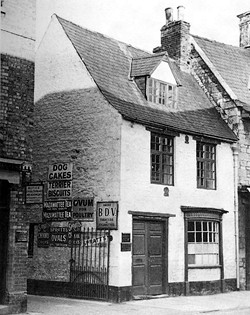 |
The shop premises in North Street where
Edward Wherry started the family business in 1806. This quaint
property with its distinctive bow window survived until 1989 when it was demolished to make way for the £1½ million
Burghley Centre development. New premises had been built by
the company on the garden behind but they were closed down on
3rd April 1970 when the firm ended grocery trading after more
than 160 years, blaming rising costs for the decision, and 23
people lost their jobs but were offered alternative employment
by the firm. |
|
|
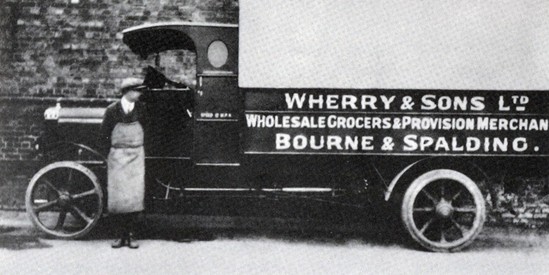 |
|
The lorry used for grocery deliveries during
the early years of the 20th century. |
|
 |
|
The wholesale
grocery despatch warehouse where goods from the factories were
received, checked and packed for onward distribution to local
shops, many of them in the surrounding villages. This service
continued for generations until the advent of the supermarkets
which caused the business to decline. |
|
 |
|
The old pea factory in Church Walk photographed
from the church tower by Trevor Brodrick, circa 1950. The plant
provided many jobs locally, mainly for women, until it closed down
in 1967 and was later demolished, together with several of the
adjoining buildings on the site, although Bourne Eau House remains
intact. |
|
This date stone was salvaged from
Wherry's pea factory in Church Walk when it was demolished in
1985 to make way for the block of flats which currently
occupies the site. It remembers William Robert Wherry
(1841-1915) who lived at Bourne Eau House which was then known
as The Cedars. |
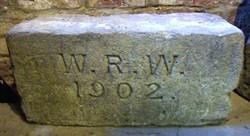 |
|
Workmen were about to throw the
stone away when it was spotted by local councillor, Don
Fisher, who rescued it and it is now on display at the
Heritage Centre in South Street. It was probably added during
alterations to the buildings in 1902 when they were then still
being used as stables by William Wherry. |
|
|
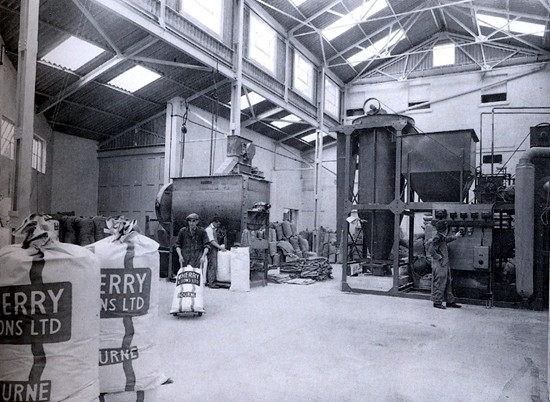 |
|
The company opened a new feed mill in Bourne in
1954 to replace the existing facility in the old South Street
warehouse |
|
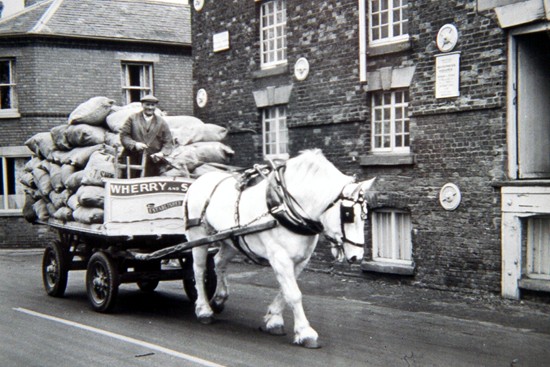 |
|
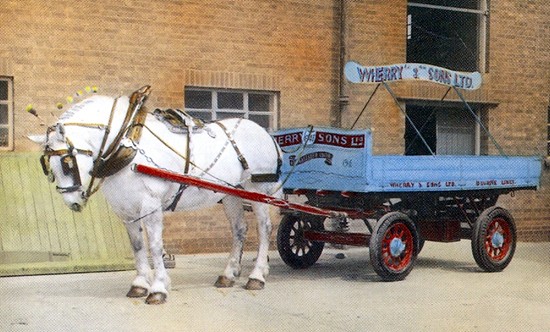 |
|
A popular sight in
Bourne in years past was Flower, pictured (above) striding out
past
the company's mill in South Street and (below) in her best harness
ready for a show. Flower was used for local deliveries by Wherry & Sons Ltd until 1967
and was known to most people as the horse with a penchant for ice
cream which was given to her regularly. |
Wherry's
gave up grocery trading on 3rd April 1970 after 160 years in business. The
premises in North Street, including the small shop with the distinctive
bow window, were later sold and demolished to make way for the Burghley
Centre development that opened in 1989. Twenty-three people employed in
the business lost their jobs but some were offered alternative employment.
The chairman at that time was Mr E K Wherry who blamed rising costs for
the closure and increasing competition from the supermarkets but he
emphasised that the company would continue with its other
activities.
He
said in a statement that the company had bought the old railway station
site in Bourne where a new pea-picking plant was being installed in the
goods shed and they intended to maintain their reputation as the best in
Britain for the supply of dried peas for human consumption.
The present day business is one of pulse specialists, pea processors and purveyors. Specialised trading
had started to evolve in the dried pea market in the early 1900s and as technology and plant breeding progressed, so did the company's expertise and association with the dried pulse crop in general. Complementing the company's trade in pulses for human consumption, its seed business has grown to be one of the leading producers of
pea and bean seed in the U K today. Success in this direction is partly due to the excellent varieties that have been marketed in the U K from exclusive agency agreements with plant breeders from around the world. Exports are made regularly and over twenty countries have been supplied in recent years, including seed to Europe and pulses for human consumption to the Middle and Far East.
|
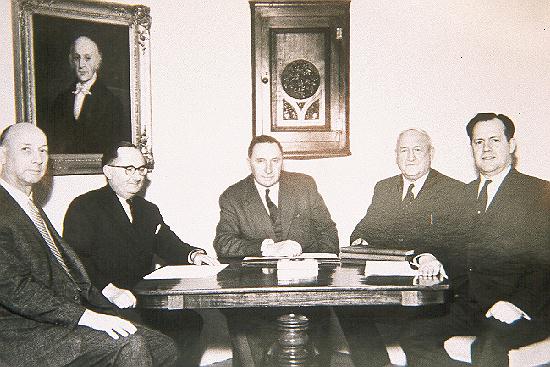 |
|
The directors of Wherry & Sons Ltd pictured
(above) at a
board meeting in March 1966. They are, from left to right, D J
Randall, V F C Wherry, E K Wherry, A W Wherry and P Y Wherry. A portrait
of the firm's founder, Edward Wherry, hangs on the wall behind them.
The local M P, Mr Quentin Davies, paid a visit to the company on Friday
12th April 1991 (right) when he was give a tour of the premises and
shown the various processes in which it was involved. The M P was
accompanied by Councillor Don Fisher who is pictured here (right) with
Mr Davies (centre) and the company chairman James Wherry (left). |
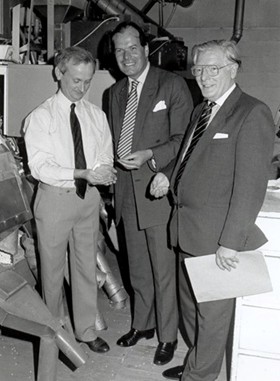 |
See also
Seven generations of a family business William Wherry
Albert E K Wherry
Eastgate Mill
Wherry's Mill
Burghley Street warehouse

Go to:
Main Index Villages
Index
|









